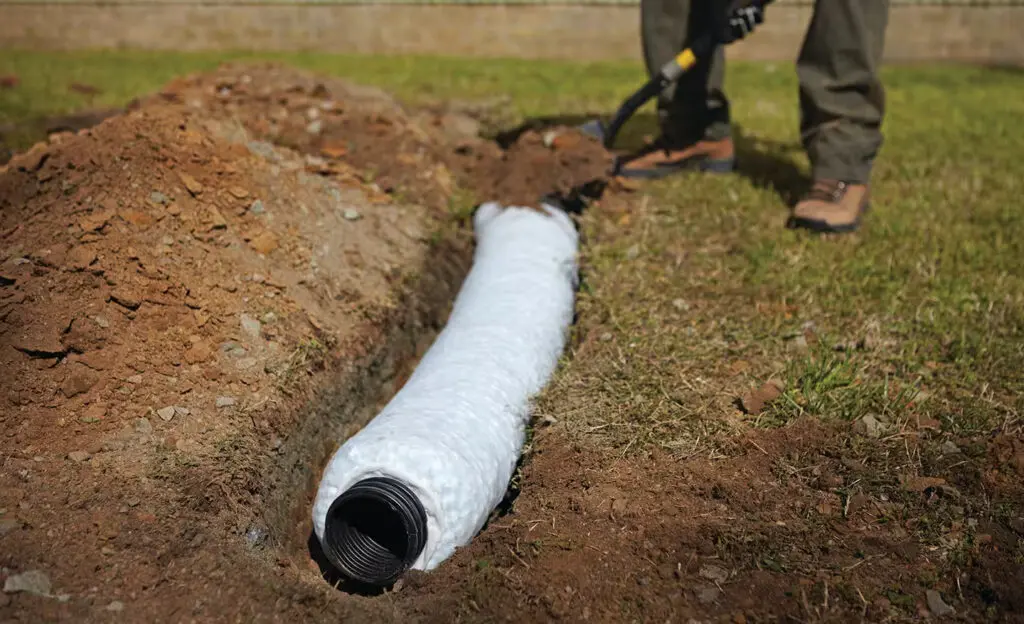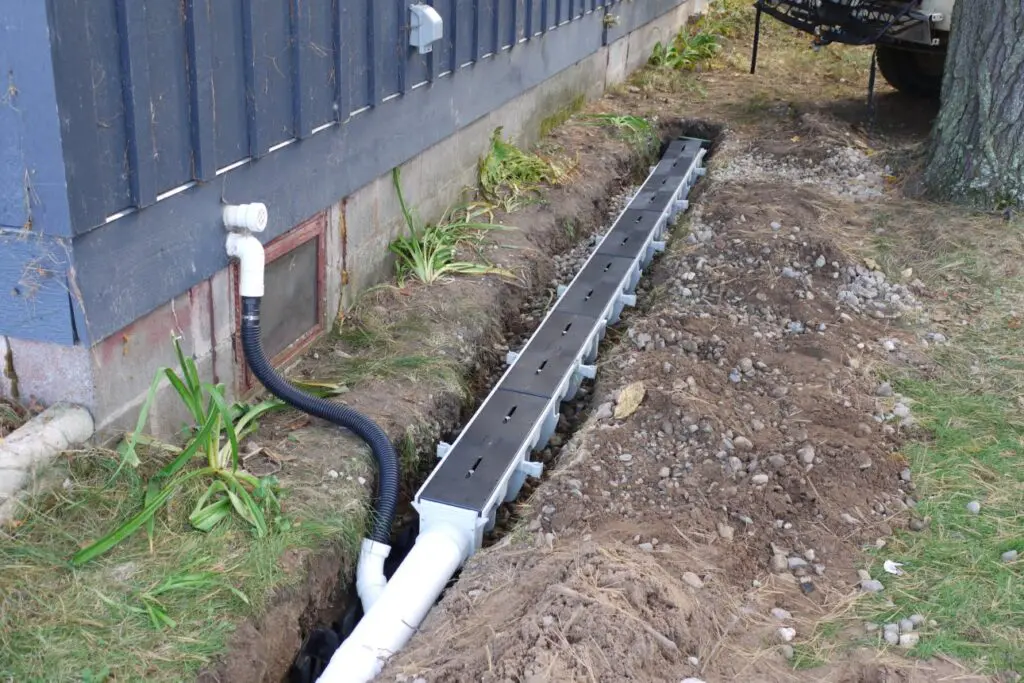How Does a French Drain Work? French Drain Installation Tips
If you’ve noticed water pooling around your home or yard, a French drain might be the solution. It’s an effective way to redirect water and prevent drainage issues. But what is a French drain system exactly? It’s a trench filled with gravel or rock containing a perforated pipe that redirects surface water and groundwater away from your property. This system helps protect your foundation and landscaping from water damage.
In this guide, we’ll explain how a French drain works, its benefits, and maintenance tips to keep it functioning properly for years.
How does a French drain work?
A French drain redirects water away from areas prone to flooding. It’s a trench filled with gravel and a perforated pipe that carries water underground to a drainage system or safe outlet.
Key Takeaways
- A French drain helps redirect water away from problem areas by using gravity and a perforated pipe system.
- French drains are commonly used to manage excess water around foundations, in basements, and in yards.
- Regular maintenance of the system is necessary to ensure it continues to function effectively.
What is a French Drain?

French drains can be installed as a DIY project, but they do require specific knowledge and tools. Here’s an overview of the steps involved for French drain repair in Fort Lauderdale, especially if you’re dealing with persistent moisture issues or water intrusion.
Essentially, it is a trench filled with gravel or rock and contains a perforated pipe that allows water to flow through it.
The pipe redirects the water to a designated area where it can be safely disposed of, such as a dry well, storm drain, or a lower part of the yard.
The Origins of the French Drain
The French drain was invented in the 19th century by Henry Flagg French, a farmer and lawyer from Massachusetts.
He designed it to help his farm by preventing water from accumulating in his fields.
Today, French drains are still widely used in both residential and commercial settings for managing water.
How Does a French Drain Work?
The primary function of a French drain is to redirect water from problem areas. It achieves this by using a trench filled with gravel or rock to help water flow away from the targeted area. If you’re wondering what does a French drain look like, it’s typically a shallow trench lined with landscape fabric, filled with gravel, and containing a perforated pipe that allows water to flow through and be carried away from your property. The top may be covered with more gravel or even sod to blend in with the surrounding landscape.
Here’s a more detailed explanation of how the system works:
1. Water Collection
Water tends to collect in areas where the ground is flat or where natural water flow is blocked.
When rain falls or snow melts, this water can gather, especially around foundations, driveways, or basements.
The French drain’s trench is strategically placed in areas where water accumulates most often, like near your home’s foundation or in a low spot in your yard.
2. Perforated Pipe
The trench is lined with a perforated pipe, which has small holes throughout its length. This pipe is designed to collect water from the surrounding soil.
As water enters the trench, it filters through the gravel or rock and then flows into the perforated pipe.
3. Redirecting Water
Once the water enters the pipe, it flows through the system. The pipe is often laid at a slight slope to allow gravity to carry the water away from the problem area.
The water can be redirected to a storm drain, dry well, or any other designated disposal point away from the building or yard.
4. Gravel or Rock Filter
The gravel or rock surrounding the perforated pipe acts as a filter, allowing water to flow through while blocking large debris from entering the pipe.
This filtration prevents the pipe from getting clogged with dirt, leaves, or other unwanted material.
Installing a French Drain

While installing a French drain can be a manageable DIY project if you’re equipped with the right tools and a bit of know-how, more complicated drainage problems often call for expert French drain cleaners to ensure the job is done efficiently and effectively. For reliable and efficient results, consider hiring the best French drain cleaning in Miramar to handle stubborn blockages and ensure long-term functionality.
Whether you’re dealing with stubborn clogs or maintenance concerns, services like French drain cleaning in Doral or French drain cleaning in Pembroke Pines can ensure the system works as it should.
Below are the basic steps for installing a French drain:
1. Choose the Right Location
Identify the area where water collects, such as along the foundation of your home or in a low spot in the yard.
Plan the route for the trench, ensuring it leads away from the problem area and directs water to a proper drainage outlet.
2. Dig the Trench
Dig a trench about 6 inches wide and 18 to 24 inches deep, depending on the size of the area you need to drain. This measurement also answers the common question: how wide should a French drain be—typically around 6 inches, though it can vary based on the volume of water being managed. The ideal depth for a French drain typically ranges from 18 to 24 inches to ensure proper water flow and effective drainage. However, this can vary based on the specific drainage needs and the surrounding terrain.
The trench should slope away from the problem area to ensure water flows in the right direction.
3. Lay the Gravel or Rock
Place a layer of gravel or rock at the bottom of the trench to help filter water before it enters the pipe. This will also help prevent clogging.
4. Install the Perforated Pipe
Lay a perforated pipe on top of the gravel. The holes in the pipe allow water to enter and flow through the system. Ensure that the pipe has a slight slope so water moves easily through it.
5. Cover the Pipe
Once the pipe is in place, cover it with more gravel or rock. This acts as a filter, preventing dirt and debris from entering the pipe.
6. Fill the Trench
Fill the trench with soil or sod to complete the installation. Ensure the surface is level, and water can flow smoothly towards the drainage area.
Frequently Asked Questions
1. What is the purpose of a French drain?
A French drain is designed to redirect water away from areas where it tends to accumulate, such as around foundations, yards, and basements. It helps prevent flooding and water damage.
2. How deep should a French drain be?
The depth of a French drain can vary depending on the area being drained, but a typical depth is 18 to 24 inches. The trench should slope slightly to allow gravity to carry the water away.
3. How often should a French drain be cleaned?
French drains typically require minimal maintenance. However, it’s a good idea to check them for debris and sediment buildup once or twice a year, especially after heavy rainfall or storms.
Conclusion
A French drain is a simple but effective solution for managing water runoff and preventing flooding in your home and yard.
Whether you’re dealing with water pooling around your foundation, flooding in your yard, or moisture in your basement, a French drain can help you maintain a dry and safe environment.
Regular maintenance and proper installation are key to ensuring your French drain works efficiently for years to come. If you’re planning to install one, you might be wondering, how much does it cost to install a French drain? The price can vary depending on factors like the length of the drain, soil conditions, and whether it’s installed inside or outside the home.
If you’re unsure about the installation or maintenance process, consider consulting a professional to make sure it’s done right.
